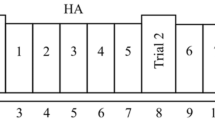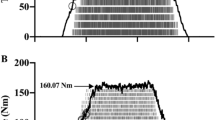Summary
The maximal instantaneous muscle power (\(\dot w_{i,\max } \)) probably reflects the maximal rate of adenosine 5′-triphosphate (ATP) hydrolysis (\(A\dot TP_{\max } \)), a temperature-dependent variable, which gives rise to the hypothesis that temperature, by affecting\(A\dot TP_{\max } \), may also influence\(\dot w_{i,\max } \). This hypothesis was tested on six subjects, whose vastus lateralis muscle temperature (T muscle) was monitored by a thermocouple inserted approximately 3 cm below the skin surface. The\(\dot W_{i,\max } \) was determined during a series of high jumps off both feet on a force platform before and after immersion up to the abdomen for 90 min in a temperature controlled (T=20±0.1°C) water bath. ControlT muscle was 35.8±0.7°C, with control\(\dot W_{i,\max } \) being 51.6 (SD 8.7) W · kg−1. After cold exposure,T muscle decreased by about 8°C, whereas\(\dot w_{i,\max } \) 27% lower. The temperature dependence of\(\dot W_{i,\max } \) was found to be less (Q 10 < 1.5, whereQ 10 is the temperature coefficient as calculated in other studies) than reported in the literature for\(A\dot TP_{\max } \). Such a lowQ 10 may reflect an increase in the mechanical equivalent of ATP splitting, as a consequence of the reduced velocity of muscle contraction occurring at lowT muscle.
Similar content being viewed by others
References
Aikäs E, Karvonen MJ, Piironen P, Ruostenoja R (1962) Intramuscular, rectal and oesophageal temperature during exercise. Acta Physiol Scand 54: 366–370
Aschoff J, Wever R (1958) Kern und Schale im Wärmehaushalt des Menschen. Naturwissenschaften 45: 477–485
Bazett HC, McGlone B (1927) Temperature gradients in the tissues in man. Am J Physiol 82: 415–435
Bennett AF (1984) Thermal dependence of muscle function. Am J Physiol 247: R217-R229
Bergh U, Ekblom B (1979) Influence of muscle temperature on maximal muscle strength and power output in human skeletal muscles. Acta Physiol Scand 107: 33–37
Binkhorst RA, Hoofd L, Vissers ACA (1977) Temperature and force-velocity relationship of human muscles. J Appl Physiol 42: 471–475
Binzoni T, Ferretti G, Barbalat F, Cerretelli P (1990) Energetics of resting anaerobic frog gastrocnemius at different temperatures by31P-NMR. Respir Physiol 82: 137–148
Blomstrand E, Bergh U, Essen-Gustavsson B, Ekblom B (1984) Influence of low muscle temperature on muscle metabolism during intense dynamic exercise. Acta Physiol Scand 120: 229–236
Cerretelli P, di Prampero PE, Piiper J (1969) Energy balance of anaerobic work in the dog gastrocnemius muscle. Am J Physiol 217: 581–585
Curtin NA, Davies RE (1975) Very high tension with very little ATP breakdown by active skeletal muscle. J Mechanochem Cell Motil 3: 147–154
Davies CTM, Rennie R (1968) Human power output. Nature 217: 770–771
Davies CTM, Young K (1983) Effect of temperature on the contractile properties and muscle power of triceps surae in humans. J Appl Physiol 55: 191–195
di Prampero PE (1981) Energetics of muscular exercise. Rev Physiol Biochem Pharmacol 89: 143–222
di Prampero PE, Meyer M, Cerretelli P, Piiper J (1978) Energetics of anaerobic glycolysis in dog gastrocnemius. Pflügers Arch 377: 1–8
Ferretti G, Gussoni M, di Prampero PE, Cerretelli P (1987) Effects of exercise on maximal instantaneous muscular power of humans. J Appl Physiol 62: 2288–2294
Hill AV (1938) The heat of shortening and the dynamic constants of muscle. Proc Roy Soc B 126: 136–195
Jones NL, McCartney N, Graham T, Spriet LL, Kowalchuk JM, Heigenhauser GJF, Sutton JR (1985) Muscle performance and metabolism in maximal isokinetic cycling at slow and fast speeds. J Appl Physiol 59: 132–136
Karlsson J, Saltin B (1970) Lactate, ATP, and CP in working muscles curing exhaustive exercise in man. J Appl Physiol 29: 598–602
Karlsson J, Nordesjö LO, Jorfeldt L, Saltin B (1972) Muscle lactate, ATP, and CP levels during exercise after physical training. J Appl Physiol 33: 199–203
Kushmerick MJ (1983) Energetics of muscle contraction. In: Peachey LD, Adrian RD, Geiger SR (eds) Handbook of physiology. Skeletal muscle. Bethesda, Md., American Physiological Society, pp 189–236
Lännergren J, Lindblom P, Johansson B (1982) Contractile properties in two varieties of twitch fibres in Xenopus laevis. Acta Physiol Scand 114: 523–535
Marechal G, Beckers-Bleucks G (1966) Adenosine triphosphate and phosphorylcreatine breakdown in resting and stimulated muscles after treatment with 1-fluoro-2,4-dinitrobenzene. Biochem Z 345: 286–299
Mitchell JW, Galves TL, Hengle J, Myers GE, Siebecker KL (1971) Thermal response of human legs during cooling. J Appl Physiol 29: 859–865
Paintal AS (1965) Effects of temperature on conduction in single vagal and saphenous myelinated nerve fibres of the cat. J Physiol (Lond) 180: 20–49
Petrofsky JF, Phillips CA (1981) The influence of temperature, initial length and electrical activity on the force-velocity relationship of the medial gastrocnemius muscle of the cat. J Biomech 14: 297–306
Ranatunga KW (1982) Temperature dependence of shortening velocity and rate of isometric tension development in rat skeletal muscle. J Physiol (Lond) 329: 465–483
Saltin B, Hermansen L (1966) Esophageal, rectal, and muscle temperature during exercise. J Appl Physiol 21: 1757–1762
Saltin B, Gagge AP, Stolwijk JAJ (1968) Muscle temperature during submaximal exercise in man. J Appl Physiol 25: 679–688
Sargeant AJ (1987) Effect of muscle temperature on leg extension force and short-term power output in humans. Eur J Appl Physiol 56: 693–698
White HD, Taylor EW (1976) Energetics and mechanism of actomyosin adenosine triphosphatase. Biochemistry 15: 5818–5826
Wilkie DR (1950) The relation between force and velocity in human muscle. J Physiol (Lond) 110: 249–280
Woledge RC, Curtin NA, Homsher E (1985) Energetic aspects of muscle contraction. Academic Press, London
Author information
Authors and Affiliations
Rights and permissions
About this article
Cite this article
Ferretti, G., Ishii, M., Moia, C. et al. Effects of temperature on the maximal instantaneous muscle power of humans. Europ. J. Appl. Physiol. 64, 112–116 (1992). https://doi.org/10.1007/BF00717947
Accepted:
Issue Date:
DOI: https://doi.org/10.1007/BF00717947




